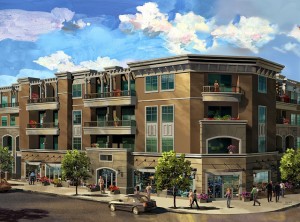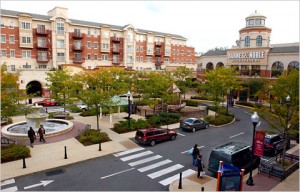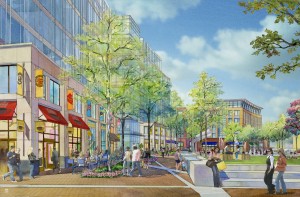By Diane Frances Luebs

Plans for Mixed-Use Development in Los Angeles
Source: Neighborhood Council of Westchester and Playa Del Rey
Mixed-use development is one strategy that cities can use to decrease their carbon footprint. This strategy involves creating neighborhoods that have homes, businesses, and commercial buildings in the same area. In some cases, this could even involve multiple types of building uses within one structure. This type of development will increase density in a way that can avoid issues with aesthetic monotony. Mixed-use development is beneficial because it can help create walkable cities, decrease sprawl, leave room for green space, and in general can reduce a community’s impact on the environment. This is in addition to economic and health benefits. As cities develop, they should work to increase mixed-use spaces.
One main benefit of mixed-use areas is that they create a more walkable community and can eliminate the need for a car since all the necessary buildings are in the same area (Haughey). Walking is a means of transportation that does not negatively impact the environment since it does not require the burning of fossil fuels. It also promotes a healthy lifestyle, without the cost and extra time of going to the gym. A smart community design can help individuals realize that single occupant vehicles are not the only convenient methods of transportation (Haughey). This walkable community can be created as a way to minimize a city’s carbon footprints while contributing to the well-being of its residents.
This type of development also leads to increased density. Density is a term that tends to induce negative reactions. When done correctly, though, density can help a community. For instance, increased density could make it easier to increase public transportation in an effective manner. For a light rail system to be effective, there needs to be a density of 12,000-15,000 people for acre (George Frantz interview, November 20, 2013). Subways require 15,000-20,000 people per acre, and busses require 7,000 people per acre (George Frantz interview, November 20, 2013). Since mixed-use areas are inherently more dense than typical suburban areas, there is a larger amount of people that can use the available transit options. This increases the ability for a community to financially support public transportation.
Density is also beneficial because it minimizes land use. Currently, the US loses 2 million acres of land annually because of development (Haughey). Creating mixed-use, infill housing can decrease sprawl and allow more space to remain as natural land. A decrease in sprawl also leads to a decrease in travel time. As of right now, the average person spends over an hour in their vehicle (Haughey). Increased density can help decrease this number.
Another result of mixed-use housing is that there are more people in one area. This increased density is beneficial in a social respect, since it increases the likelihood that an individual will encounter neighbors. These encounters will increase further if neighborhoods make the effort to create public nodes for interaction, as seen in the below picture. Since mixed-use housing can fit the same amount of people in a smaller area than a suburb can, there is more space for these public nodes.
In instances where mixed-use development increases the amount of attached homes, heating costs in homes could decrease. This is because there will be fewer walls exposed to cold outdoor temperatures, and more heat is able to remain in the building. This requires less additional heat to keep the building warm, which leads to decreased cost and decreased carbon emissions.
One potential negative aspect of mixed-use housing is the lack of backyards. However, since there is increased density, there is an increase in the amount of area that can be devoted to green space. While this is not owned by one particular individual, it could be a pleasant substitute for backyards. This space could potentially be larger than the standard individual back yard and it encourages social interaction with other community members. Also, these green spaces may have room for public amenities, such as tennis courts, basketball courts, or playgrounds.
One hindrance to mixed-use development is zoning. Some areas are zoned specifically for commercial areas, or specifically for residential uses. Though it is a time-consuming process to change zoning laws, it is beneficial to do so, as seen by the aforementioned benefits of this type of development. Another hindrance is that sometimes mixed-use areas are being created in current commercial areas and, in the process, are interrupting the existing business (Bady). Though this may be detrimental for the business in the short term, the stores will receive a new customer base once construction is done. Individuals that move into the newly residential buildings will be more likely to shop in stores that are in their area. This can help the businesses flourish in the long run.
Despite a few setbacks, mixed-use housing brings numerous benefits to a community. It increases density, which could leave more room for open space and could help support public transportation. It also leads to a more walkable community, thus helping individuals reduce their impact on the environment. The idea of mixed-use housing involves ideas such as density and no personal backyards, which people do not like to hear. However, after fully examining this housing option, communities may realize how beneficial this type is development is. With this knowledge, communities should work to change zoning codes to allow for mixed-use development and thus facilitate sustainable actions.
Works Cited
Bady, S. (2010). Mastering mixed-use housing. Professional Builder. Retrieved from http://search.proquest.com/docview/1275816040?accountid=10267
Haughey, R. (2005). Higher-Density Development: Myth and Fact. Washington D.C.: ULI–the Urban Land Institute.



